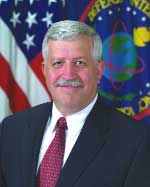DIA gets its servers in line


Connecting state and local government leaders
The Defense Intelligence Agency goes to server automation for its collection of networks to help meet the growing demand for data.

Our primary secret network [includes] 3,000-plus servers, 800 to 900 applications, 20,000-plus desktops.' Mark Greer, DIA
Kim Steele
Perhaps nowhere is the demand more evident than at the Defense Intelligence Agency, which is directly responsible for providing information that can be acted on to U.S. military forces deployed around the world.
'We have grown recently,' said Mark Greer, DIA's deputy CIO and vice deputy director for information management. 'We are, in essence, a global business. We provide [information technology] needs for all the 10 combatant commands [and] the IT at every attach' office.'
That's why DIA has turned to server automation software to help keep all its networks secure and healthy.
Under a contract with Opsware Inc. of Sunnyvale, Calif., the project covers networks that serve more than 7,500 military and civilian employees worldwide. Greer said there are about 1,500 IT employees'20 percent of the total'and another 1,200 IT contractors supporting the agency's mission.
To help handle the expanded scope of DIA's operations, Greer said the agency has restructured much of its IT operations, putting in place five regional service centers, four in the United States and one in Europe.
Today, the agency provides support for more than 20 different networks, four of them 'of significant size,' all with different security classifications, including a number of small networks knitting together coalition partners, he said.
'Our primary secret network [includes] 3,000-plus servers, 800 to 900 applications, 20,000-plus desktops,' Greer said. 'There are about 250 room-based video teleconferencing centers [VTCs] ... inside [sensitive, compartmented-information facilities] and about 1,000 desktop VTCs.'
And that's just one network.
'If we're going to look across the whole enterprise, we need to have a standard, consistent baseline across the whole enterprise, not just this building,' he said.
DIA is taking the enterprise approach to gain efficiencies and economies of scale, improve its security posture and strengthen its patch management efforts, he said. 'That probably increases the security of the networks by an order of magnitude.'
DIA automated all these processes to help connect the far-flung structure of the enterprise. Sending an army of men and women around the globe to handle server care and feeding is not an effective use of their skills, Greer said.
'The capabilities are really designed to allow enterprises and large IT organizations to bring efficiency and consistency to the management of a large, heterogeneous server environment,' said John Menkart, director of government sales for Opsware. 'It's really not dependent on size [or] the amount of change in an environment. ... We give customers a full view of their applications, from the servers' to the desktop. 'We would host [the applications] and enable you to deploy new versions' over the Web.
Besides DIA, Opsware server automation software is in place at some of the Energy Department laboratories, the Army Knowledge Online site and the Federal Reserve, to name a few, Menkart said.
'Several organizations have found it extremely valuable for [continuity of operations]; it eliminates redundancy easily,' he said.
Purchasing a commercial solution for an enterprisewide problem in an intelligence agency is a big step.
'It reflects a history of government silliness,' he said. 'A server is a server, it is physically maintained and cared for at Ford Motor Co. the same way as in our building. There was a mistaken belief that we were different from businesses, that we were special.'
Greer said the nuts and bolts of IT should be completely transparent to users'like 'turning on the lights in a room.'
'Our gut feeling is that we spend two-thirds of our budget' on tending to the networks and 'only one-third on the high-end, analytical things that matter to the warfighter. We'd like to have the preponderance of our IT dollars going to high-value for the warfighter and decision-maker.'
Leveraging commercial lessons learned and best practices, Greer said, provides a more suitable challenge. 'When we can achieve significant manpower reductions, how do we capitalize on that?' he said.
DIA began deploying the Opsware software in May. The agency is at initial operating capability on one of its networks, and it is fully deployed on the top-secret network, Greer said. DIA employees still are writing scripts for many of the agency's applications on other networks, he said, which have to be completed before the rollout is finished. 'We anticipate completing it by the end of fiscal 2007,' Greer said.
NEXT STORY: GSA schedules a place for HR line of business




